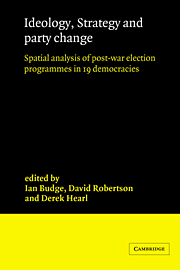 Ideology, Strategy and Party Change
Ideology, Strategy and Party Change Published online by Cambridge University Press: 27 October 2009
POLITICAL PARTIES IN BELGIUM
As with the Netherlands, Belgian politics were relatively straightforward until the mid-1960s. Following the introduction of universal male suffrage in 1919, the then two-party opposition between Catholics and Liberals gave way to a classic ‘two-and-half’ party system in which the Socialist Party replaced the Liberals as the Catholics' chief rival. With few exceptions, governments were coalitions between two of these three ‘traditional’ parties formed in response to their gains and losses at successive General Elections. Two major cleavages seemed to underpin this system – a ‘left–right’ socio-economic cleavage together with an older ‘clerical/anti-clerical’ division which had divided Catholics from Liberals ever since the foundation of the State in 1830. Both changed after the Schools Pact of 1958 and the so-called Loi Unique or economic austerity package introduced by the Eyskens (Christian–Social/Liberal) government in the wake of Congo Independence in the 1960s. The former was effectively a ‘truce’ between the three parties concerning the last major clerical/anti-clerical issue. The second threw into sharp relief the growing economic disparity between the country's two main language regions, Flanders and Wallonia. The sudden removal of the clerical/anti-clerical cleavage allowed what had hitherto been a submerged division to rise to the surface. This ran across all three traditional parties, and had rapid and profound effects upon the party system.
‘Community’ issues and associated sub-cleavages have progressively given rise first to new parties and then to forced divisions among the traditional parties – generally along language lines.
To save this book to your Kindle, first ensure no-reply@cambridge.org is added to your Approved Personal Document E-mail List under your Personal Document Settings on the Manage Your Content and Devices page of your Amazon account. Then enter the ‘name’ part of your Kindle email address below. Find out more about saving to your Kindle.
Note you can select to save to either the @free.kindle.com or @kindle.com variations. ‘@free.kindle.com’ emails are free but can only be saved to your device when it is connected to wi-fi. ‘@kindle.com’ emails can be delivered even when you are not connected to wi-fi, but note that service fees apply.
Find out more about the Kindle Personal Document Service.
To save content items to your account, please confirm that you agree to abide by our usage policies. If this is the first time you use this feature, you will be asked to authorise Cambridge Core to connect with your account. Find out more about saving content to Dropbox.
To save content items to your account, please confirm that you agree to abide by our usage policies. If this is the first time you use this feature, you will be asked to authorise Cambridge Core to connect with your account. Find out more about saving content to Google Drive.